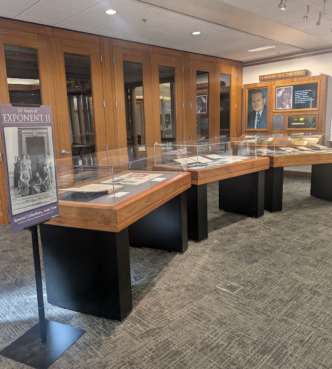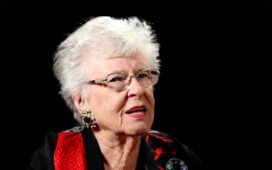(RNS) — When you tell people you research and write about Mormon feminism, they have questions. Can you be truly faithful and be a feminist? Can you be pro-woman and be part of an overtly patriarchal organization? The word “oxymoron” comes up a lot.
As co-authors of the book “Fifty Years of Exponent II,” published last year, we’ve found the last half a century to be filled with ups and downs. Especially when you consider the history of Exponent II — the longest-running independent publication for Mormon women and gender minorities — it’s clear the faith’s contradictions on women’s issues have been fertile ground for growth.
Exponent II has a history laced with tension and irony. For example, its archives now sit in the special collections department at Brigham Young University, which is named for Latter-day Saint apostle L. Tom Perry — the same church leader who, in 1975, flew to Boston to urge the magazine’s founding editor to step down at the request of top church authorities. As LDS leaders centralized the church’s authority through a process called correlation, they saw independent publications like Exponent II — which they feared might challenge traditional gender roles — as a threat to their control over the church’s message and missionary efforts.
The attempt to shut the paper down when it was barely a year old failed, though. Claudia Bushman, the founding editor and wife of Richard Bushman, then-regional church leader of congregations in Boston, instead stepped aside in the spirit of “obedience, but not repentance.”
Ironically, this past month, the L. Tom Perry Special Collections hosted a Women’s History Month exhibit, also titled “50 Years of Exponent II.” Curated by archivists at the BYU library, the exhibit told the publication’s story through photos of the organization’s founding mothers, early issues of the paper, fan mail, contributor letters and a copy of our book. There was also a QR code linking to a newly digitized, word-searchable archive of the quarterly publication.

Brigham Young University’s “50 Years of Exponent II” exhibit took place in the L. Tom Perry Special Collections, named after the LDS apostle who 50 years ago urged the feminist periodical’s founding editor to quit her role. (Courtesy photo)
After decades of tension, has The Church of Jesus Christ of Latter-day Saints — and its flagship university, BYU — softened its stance toward feminism?
Not surprisingly, the answer is and has remained complicated.
When in 1974, a small group of Boston-area housewives, graduate students and young professionals started the quarterly newspaper founded on “the dual platforms of Mormonism and feminism,” they weren’t inventing something new. They named their paper after the Woman’s Exponent, an independent LDS publication that from 1872 to 1914 advocated for women’s suffrage and made space for women’s rights alongside their faith.
Then and now, it seems contradictory that the 19th-century paper’s longtime editor, Emmeline Wells, and many of its writers were both proto-feminists and polygamist wives —women navigating a deeply patriarchal tradition while exerting their agency.
A century later, Exponent II emerged during the second-wave feminist movement as Mormon women again sought to explore the tensions of their lives.
It quickly became a national platform with thousands of subscribers, connecting dispersed pockets of Mormon feminists.
The women behind Exponent II saw their work as an act of devotion — developing the talents of Mormon women in service to the church and their local communities. So, they were perhaps naively surprised when church leaders met their efforts with suspicion.

Exponent II staff retreat at Grethe Peterson’s farmhouse in Winchendon, Mass., September 1975. Back row: Grethe Peterson, Claudia Bushman, Mimmu Hartiala-Sloan, Laurel Thatcher Ulrich, Bonnie Horne, Kaye Clay, Vicki Clarke. Front row: Judy Dushku, Tricia Butler, Nancy Dredge and Connie Cannon. (Courtesy photo)
Still, their efforts bore fruit. Exponent II co-founder Laurel Thatcher Ulrich went on to earn a Ph.D. in history and, in 1991, won the Pulitzer Prize for “A Midwife’s Tale: The Life of Martha Ballard, Based on Her Diary, 1785–1812.”
Ulrich spoke to BYU’s honor students in early 1992 but learned later that year she’d been quietly banned from future appearances. The reason? Her Exponent II columns, which had gently suggested the church could do more to include women in its official histories.
The early 1990s marked a period of retrenchment for the LDS church. Apostle Boyd K. Packer identified what he saw as the three greatest threats to the church: the gay and lesbian rights movement, the feminist movement and “so-called scholars or intellectuals.” This mindset fueled a series of high-profile disciplinary actions in 1993, including the coordinated excommunications of several Mormon scholars and feminists, a group that came to be known as the “September Six.”
Feminists at BYU acutely felt the effects of this retrenchment. The feminist club VOICE emerged, leading Take Back the Night marches to protest violence against women and sponsoring speaker series. Also in 1993, Cecilia Konchar Farr, an outspoken professor of American literature and feminist theory, was fired from BYU, sending a message to students and faculty that the church would decide what brand of feminism was acceptable.

Charter Exponent II women Nancy Dredge and Judy Dushku visit the Brigham Young University exhibit in March 2025. (Courtesy photo)
Although Mormon feminism quieted for a time, it never disappeared. In the 2000s, it roared back to life through online writing, especially through the so-called Bloggernacle — a network of blogs where Latter-day Saints discussed faith, culture and doctrine.
That’s also when scholars and activists Jana Remy and Caroline Kline helped bring Exponent II into the digital age. After guest editing a print issue in 2005, they launched the Exponent II blog, which has now published daily content for nearly two decades.
The internet and Mitt Romney’s run for the U.S. presidency made conversations public that the LDS church had preferred stay private. In recent years, it has taken steps toward a more open approach to its history, and one that begins to acknowledge past challenges.
But are they getting better at talking about gender equality?

“Fifty Years of Exponent II” by Katie Ludlow Rich and Heather Sundahl. (Courtesy image)
Recent guest columnist Emily Jensen wrote that the church’s messaging suggests otherwise. Men’s voices still often dominate women’s church meetings. Men still ask for women’s voices while simultaneously ignoring, sidelining or excommunicating women whose voices they find threatening.
As surveys reveal Gen Z women are now leaving religion, including Mormonism, at higher rates than men, some male BYU professors who study faith loss are baffled as to the cause. But women’s voices have been there all along, and they have been willing to talk about their faith and frustrations.
Despite BYU’s fraught relationship with feminism, Exponent II began sending its papers to the university’s archives in 1977. The LDS church has long prioritized preserving documents and encourages its members to keep records and journals. And for 50 years, Exponent II has added to the body of evidence of what it means to live as a Mormon woman.
While writing and publishing gave Mormon feminists a voice, BYU preserving their work allowed us to write a well-documented history. And today, BYU displays what Exponent II has made visible all along: While the church has often sidestepped questions of gender equality, its women have not.
(Katie Ludlow Rich is a writer and independent scholar living in Saratoga Springs, Utah. Heather Sundahl is a writer and marriage and family therapist living in Orem, Utah. The views expressed in this commentary do not necessarily reflect those of RNS.)















